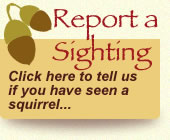Monitoring Squirrels
Monitoring Squirrels
Introduction
 Any plan for the conservation of wildlife has to be based on aknowledge of where the chosen subject is found, and how many there are. The red squirrel is no exception, and it is important that we continue gathering this information to guide present and future conservation work.
Any plan for the conservation of wildlife has to be based on aknowledge of where the chosen subject is found, and how many there are. The red squirrel is no exception, and it is important that we continue gathering this information to guide present and future conservation work.
In south Scotland, sightings of red and grey squirrels are collected by the Red Squirrels in South Scotland project and fed into regional and national databases. These records show us where the two species of squirrel have occurred in the past, and provide us with a general picture of present distribution. However, there is a need to build on this with more detailed information if advice is to be given on where and how red squirrel conservation work should be undertaken.
Monitoring Squirrels in South Scotland
 The following survey methods are being used in south Scotland as part of on-going squirrel monitoring programs. Many of them rely on support from the general public, and the help of local red squirrel groups to co-ordinate the work. If you are interested in helping to survey squirrels, please contact the Red Squirrel Project Officer for your region.
The following survey methods are being used in south Scotland as part of on-going squirrel monitoring programs. Many of them rely on support from the general public, and the help of local red squirrel groups to co-ordinate the work. If you are interested in helping to survey squirrels, please contact the Red Squirrel Project Officer for your region.
Survey Method |
Description |
Time of Year |
Sightings |
The project is always keen to receive reports of squirrel sightings – both red and grey. Please complete our online Squirrel Sightings Form if you should see a red or a grey squirrel |
Ongoing |
Hair analysis |
Squirrel Specific Feeder Boxes are used in and around woodlands to determine the presence or possible absence of red and grey squirrels. These boxes contain sticky blocks, which collect hair from squirrels entering to reach food inside. Analysis of the hair can tell which type of squirrel was feeding. |
Spring/Summer |
Cone Transects |
These surveys focus on specific woodlands and involve counting the number of squirrel eaten cones along a specified transect. This provides an estimate of red squirrels population densities and can be used to monitor fluctuations over time. |
Spring and Autumn |
Click here for a printable version (pdf)

Please note this link will open a new window which will take you to the Scottish Wildlife Trust website where you can record your squirrel sightings.
Website by
Stewartry Technology





